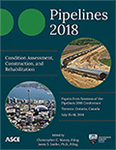Pipelines 2018
Air Pocket Detection in Water and Wastewater Conveyance Pipelines Using Inverse Transient Analysis
Publication: Pipelines 2018: Condition Assessment, Construction, and Rehabilitation
ABSTRACT
Since the presence of air can change the transient responses of pressurized pipe systems, the inverse transient analysis (ITA) may be a feasible approach for detecting entrapped air pockets. In this study, the ITA method was utilized to determine the size of the air pockets at key high points of the system. This was achieved through an optimization process in which the discrepancy between the measured and calculated transient responses (primarily pressure head and/or flow rate) are minimized. Genetic algorithm (GA) was used as the optimization engine. This paper intends to provide preliminary insight with regard to the performance of the ITA in determining entrapped air pocket sizes. The numerical results show that the ITA can capture the size of the air pockets fairly well providing that the number of population used in GA is sufficiently large. Since the number of population increases with increasing number of high points in the system, its application for real pipelines can be encumbered by the impractically long computational time. In such cases the solution is to use a more efficient optimization method and/or to perform parallel computing.
Get full access to this article
View all available purchase options and get full access to this chapter.
ACKNOWLEDGMENT
This research was funded by a grant from Enbridge Pipelines Inc., and by the Natural Sciences and Engineering Research Council of Canada Collaborative Research Development grant which are gratefully acknowledged.
REFERENCES
Chaudhry, M. (1987). Applied Hydraulic Transients. New York: Van Nostrana Reinhold Co.
Chaudhry, M. H., & Reddy, H. P. (2011). Mathematical modeling of lake tap flows. Journal of Hydraulic Engineering, 137(5), 611–614.
Colombo, A. F., Lee, P., & Karney, B. W. (2009). A selective literature review of transient-based leak detection methods. Journal of Hydro-environment Research, 2(4), 212–227.
Jönson, L. (1985). Maximum transient pressure in a conduit with check valve and air entrapment. In P. J.H. (Ed.). Int. Conf. Hydraulics of pumping stations (pp. 55–76). Cranfield: BHRA.
Liggett, J. A., & Chen, L. C. (1994). Inverse transient analysis in pipe networks. Journal of Hydraulic Engineering, 120(8), 934–955.
Malekpour, A., Karney, B., & Nault, J. (2015). Physical Understanding of Sudden Pressurization of Pipe Systems with Entrapped Air: Energy Auditing Approach. Journal of Hyraulic Engineering, 142(2), 04015044.
Martin, C. S. (1976). Entrapped air in pipelines. 2nd Int. Conf. on Pressure Surges. Cranfield, UK: BHRA Fluid Engineering.
Pozos-Estrada, O., Sanchez-Huerta, A., Breña-Naranjo, J. A., & Pedrozo-Acuña, A. (2016). Failure Analysis of a Water Supply Pumping Pipeline System. Water, 8(9), 395.
Ramezani, L., Karney, B., & Malekpour, A. (2016). Encouraging Effective Air Management in Water Pipelines: A Critical Review. Journal of Water Resources Planning and Management, 142(12), 04016055.
Simpson, A. R., Dandy, G. C., & Murphy, L. J. (1994). Genetic algorithms compared to other techniques for pipe optimization. Journal of water resources planning and management, 120(4), 423–443.
Vasconcelos, J. G., & Leite, G. M. (2012). Pressure Surges Following Sudden Air Pocket Entrapment in Storm-Water Tunnels. Journal of Hydraulic Engineering, 138(12), 1081–1089.
Wright, S. J., Determan, K. V., & Vargas, S. M. (2012). Pressure transients due to compression of trapped air in rapidly filling sewer storage tunnel. In W. James (Ed.). On Modeling Urban Water Systems-Monograph 20(pp. 2–18). Guelph, Ontario: CHI Press.
Wylie, E. B., & Streeter, V. L. (1993). Fluid transients in systems.Upper Saddle River, N.J.: Prentice-Hall.
Information & Authors
Information
Published In
Pipelines 2018: Condition Assessment, Construction, and Rehabilitation
Pages: 294 - 302
Editors: Christopher C. Macey, AECOM and Jason S. Lueke, Ph.D., Associated Engineering
ISBN (Online): 978-0-7844-8165-3
Copyright
© 2018 American Society of Civil Engineers.
History
Published online: Jul 11, 2018
Published in print: Jul 12, 2018
Authors
Metrics & Citations
Metrics
Citations
Download citation
If you have the appropriate software installed, you can download article citation data to the citation manager of your choice. Simply select your manager software from the list below and click Download.
